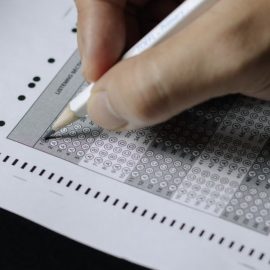

This article is an excerpt from the Shortform book guide to "How to Take Smart Notes" by Sönke Ahrens. Shortform has the world's best summaries and analyses of books you should be reading.
Like this article? Sign up for a free trial here .
What is top-down writing? How does it actually hurt your writing process?
Top-down writing is the traditional writing method where you draft a thesis and then conduct research based on your thesis statement. In other words, you create ideas to support your existing thesis rather than developing a thesis that encompasses your original ideas. This method works in theory, but in practice, it has several issues.
Here’s how the top-down writing approach hinders your creative process.
Why Top-Down Writing Approach Is Flawed
Most writers use top-down writing when working with their manuscripts. Normally, you read a little, come up with an original thesis, do further research on your thesis, then write your paper.
(Shortform note: The top-down method that Ahrens contends most writers use may be culturally influenced. In The Culture Map, cultural communications expert Erin Meyer explains that some Western cultures think theoretically, or top-down: They’ll first formulate a general hypothesis from which they deduce a conclusion. Writers in these cultures might be more prone to the top-down approach Ahrens advises against than writers from cultures that encourage looking at the data first before drawing conclusions.)
This top-down method works in theory. But in practice, Ahrens argues, it has three main issues—all of which you can avoid by using the bottom-up approach of the slip-box system.
1. You’ll Struggle to Find Source Material
Ahrens contends that if you research after you come up with a thesis in the top-down writing approach, you may be unable to find sufficient source material on the topic you’ve chosen. This causes frustration and—if you’ve begun researching too close to your deadline—panic.
(Shortform note: You may also struggle to source material on your chosen topic if you’re not looking in the right places. Studies note that academics prefer to research via the internet —but using your library may provide higher-quality sources.)
But if you use the slip-box system, you never lack source material on your chosen topic. In this system, you’re not researching to prove a thesis but to grow your slip-box—in other words, to increase the number of original ideas you have. You then develop your thesis based on the ideas you collected in these notes. As a result, you can only work on a thesis that has sufficient source material to support it; if the sources didn’t exist, you’d never have enough notes on the topic in your slip-box to prompt an original idea for a paper.
(Shortform note: Depending on your field, developing a thesis from your slip-box may not ensure that you have sufficient source material on your slip-box. For example, a single slip-box note prompts a scientist to ask a new research question—but if that research doesn’t yet exist, that scientist is stuck unless they did the research themselves.)
2. You’ll Fall Victim to Confirmation Bias
Ahrens argues that top-down writing makes you especially prone to confirmation bias—a human tendency to seek out information that supports our existing views. As Ahrens points out, if you already have a hypothesis when you start researching, you naturally pay more attention to information that supports your hypothesis than information that contradicts it. But if you ignore contradictory information, your argument won’t become as strong as it could be—and you might miss out on the opportunity to have a truly original insight. By using the slip-box system, you avoid or mitigate these risks. You’re more open to disparate views and less likely to be biased because you didn’t start with an idea you’re trying to prove.
(Shortform note: If you’ve spent a lot of time on an idea, you may also ignore the evidence against it because you’ve grown personally attached to it. If this is the case, consider pausing when you encounter a new idea that casts doubts on your original hypothesis: Taking a step back could help you recognize and work through any defensiveness that might arise so that you can rationally evaluate the idea. The slip-box system builds in time for this pause: Writing up a literature note takes time, which will help you view the idea more objectively.)
3. You’ll Grow Bored With Your Work
Ahrens argues that if you use top-down writing, you risk growing bored with your work. This can happen in two ways—both of which you can combat by using the slip-box system.
First, you may grow bored with your thesis. This can happen if, while researching your already-developed thesis, you gain a new insight that counters or significantly alters your thesis—or even leads you in an entirely new direction. You then face a dilemma: Do you switch tracks and throw away all the work you’ve done so far, or do you continue with your current project—even though you’re no longer fully devoted to it?
But, Ahrens contends, if you use the slip-box system, you never face this dilemma. In the slip-box system, your thesis stems from ideas you’ve gathered in the slip-box. This guarantees that 1) it’s on a topic you’re interested in—since the slip-box contains only notes on topics that intrigue you—and 2) that it’s something you’ve thought through—since an idea only gains traction in the slip-box if you’ve thought it through significantly. As such, you’re less likely to change your mind about or lose interest in your writing halfway through your project.
Second, you’ll grow bored of working on the same piece since you’re only working on one manuscript at a time. Using the slip-box system reduces this possibility because you’re constantly working on multiple projects: You’re developing the slip-box with an eye for creating notes that connect in disparate ways instead of focusing your research on a specific argument. When you work on multiple projects at once, you’re less likely to feel bored with a particular topic.

———End of Preview———
Like what you just read? Read the rest of the world's best book summary and analysis of Sönke Ahrens's "How to Take Smart Notes" at Shortform .
Here's what you'll find in our full How to Take Smart Notes summary :
- Why traditional, prewriting note-taking methods don’t work
- How to use the slip-box system method of note-taking
- How to organize and file your notes






